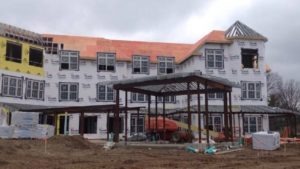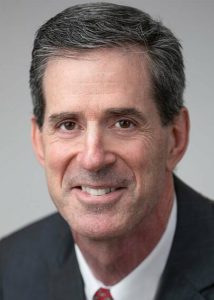
Planning to renovate, expand or build a new facility? Read this first.
If you’re looking to open a new facility or expand one already in existence, there’s a lot to know about how construction of a senior living facility works best, and how to navigate building codes, health care regulations and working with a construction firm. Here, Mitch Lapin, president of Fortney & Weygandt, a national general contractor that serves a number of different market segments, including the senior living industry, talks about what renovation or construction of a senior living facility is like from the construction firm’s perspective.
Fortney & Weygandt has completed more than 35,000 projects over the past 30 years, worth more than $2.3 billion in total. Within senior living, Fortney & Weygandt has constructed projects across the full continuum of options, from independent living to skilled nursing, memory care, rehab, and assisted living, and worked with some of the largest names in the industry.
iAdvance Senior Care: When it comes to working on senior care facilities, what are some of the challenges that crop up during these projects?
Mitch Lapin: On renovation projects, I think the biggest concern you have is not interrupting the facility’s ongoing work—not disturbing the residents or disturbing them as little as possible. One of the things we’ve found is that everyone loves to watch construction, which includes senior citizens. And so we actually worked on one project where we cut a viewing window into the protection barricade so that people could see what was going on. We got a call from the administrator and she asked the [project] superintendent to come over to the facility. She brought him in from the back side. They quietly walked up and she was amazed because there was an entire crowd of people standing around the window looking at what was going. That was one of those fun things. But that’s really the most critical thing—that we don’t interrupt their daily routine. It’s very important to have workers who are committed to maintaining that quality of life for people.
IASC: So how do you keep that small footprint? What are some of the measures you take to reduce disruption?

Mitch Lapin, president of Fortney & Weygandt
ML: It’s hard. Especially when you’re tying [a new structure] into an existing facility or renovating an existing facility. In a lot of other types of business—retail or commercial work—we’ll work at night to avoid disrupting the operator or the people who are using the facility. In this case, you can’t because obviously, people who live there are sleeping. So, you work normal hours during the day, and the most important thing is safety. If you’re affecting the path of egress for fire safety for people to get out of the building, you have to maintain that [path of egress] at all times. When you’re working in that area, you have to make sure you have a pathway, and it’s very hard for people to maintain that pathway to get out in an emergency. We work with the administrator to make sure their needs come first, but it’s hard because we have a job to do. It’s a constant battle back and forth for the subs’ who need to get their work done and the administrators’ need to make sure their residents are safe and happy. We just work with them as best we can. There’s always going to be some difficulties, but having good communication is the best way to get around it.
IASC: Now how does that whole picture change when we’re talking about a new building from the ground up?
ML: With a new facility, there’s no effect on the residents because there’s nobody in there yet. Where you have to be careful—we just finished a project in Williamsburg, Virginia, and it was a separate building in a community. So there were other facilities in that same community where residents would travel, walk, ride, and constantly be around the construction. There had to be a certain level of care taken to make sure people from the outside didn’t get hurt by either construction vehicles or by materials being left on site. You have to be very careful about your stockpile of materials, where you store materials, your lay-down area for steel or wood framing. Whatever materials you’re putting into the building have to be carefully organized. Obviously, if you’re building a new facility that’s in the middle of a field and nobody’s around, you don’t have to take the same measure of care about residents or visitors. You just have to do your standard level of care for a typical construction project.
IASC: With regard to regulations around health care, are there ever any concerns surrounding how to make sure the construction project is compliant with all regulations when it’s finished?
ML: From our perspective, no. We get a set of plans—the architect and engineer have already taken the time to make sure the bundling is compliant with any local or national regulations. So we build it to match the plans. There’s care involved when you’re turning a building over, that it’s ready for the residents. There’s a series of requirements we have to go through as far as life safety. If there’s a kitchen, the health department gets involved. The building department signs off on electrical, mechanical, plumbing, fire protection, and the building itself. And then a lot of communities have zoning requirements, so zoning has to sign-off. But for the most part, the fact that it’s an assisted living facility doesn’t change how we do our business.
IASC: What advice would you give an owner or operator who’s looking to renovate or construct a new facility about working with a contractor?
ML: Like anything else—good communication. For me, the most important thing is that they vocalize what their concerns are. Let us know what their hot buttons are. A lot of times we go into a job and we find out after we’ve done something this was something that the administrator or facility owner was very concerned about. If they had told us up front, we could have looked out for whatever it is they’re worried about. That’s really the most important thing—for them to not be shy. Tell the contractor what their expectations are and what their concerns are.
IASC: Anything else you want readers to know?
ML: It’s a process. Construction is a complicated activity and you need some patience with it. It’s amazing how when you look at a facility and you think, ‘there’s no way this will finish when it’s supposed to in three weeks or whatever.’ And mysteriously, somehow an enormous amount of work occurs in those three weeks. It’s like doing a jigsaw puzzle. When you get to the end of a jigsaw puzzle, it gets easier because there’s fewer pieces and it’s easier to find missing pieces than at the beginning. Construction is a lot the same way. When you get near the end, things move faster and it’s surprising how quickly it comes together.
The post Q&A: What to Know Before You Build or Renovate appeared first on I Advance Senior Care.
from Blog – I Advance Senior Care https://ift.tt/2lNuiLn
via IFTTT
Comments
Post a Comment